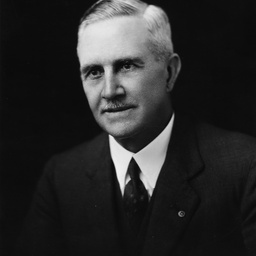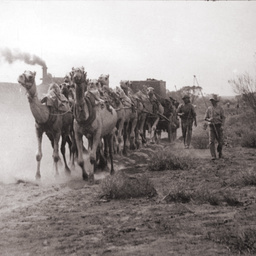Find • Port Augusta • Results 1,081 to 1,110 of 1,622


Saltia
View of a train at Saltia Railway Station, with the hotel in the middle ground. Saltia was a town between Port Augusta and Quorn. The hotel was built in 1859 to service the bullock drivers and the proprietor was David Lithgow. The train in the station has various loads on board including sacks of wheat, ore and passengers


Tarcoola mail coach
[General description] The Tarcoola mail coach has four passengers and a driver (plus a bystander with a pipe). The coach is drawn by a team of four mules. [On back of photograph] 'Tarcoola coach / Bi-weekly service to Port Augusta / presented by W.D. McKenzie'.


Unloading goods, Wilmington
Unloading supplies from horsedrawn wagons arrived from Port Augusta.


Railway Bridge, Windy Creek
[General description] Railwaymen pose with a W class locomotive on a bridge, silhouetted against the sky. One man rides a hand car. [On back of photograph] 'Railway Bridge over Windy Creek (a little south of Copley). 159 miles 50 chains north of Port Augusta / Engine is class W / probably in the 1880s'


Catholic Church, Wirrabara
Catholic Church at Wirrabara completed. The foundation stone was laid on 30 June 1930 by the Bishop of Port Augusta. The Catholic church opened in February 1931.


Woolundunga
Woolundunga Springs, the source of Port Augusta's water supply. A family of women and children are in the middle ground, possibly that of Octavius W. Wastell. They could be: Marie Louisa, Amelia Caroline, Mrs Laura Wastell (his wife), Francis Stoddart Wastell, Annie Blanche and Rosa Stoddart Wastell. Octavius Wastell was 2nd Superintendent of Waterworks at Woolundunga. A boardwalk pathway can be seen at left of view.


Sir Samuel Davenport
Sir Samuel Davenport arrived in South Australia in 1843. He and his brother moved to Macclesfield to manage a mixed farm with almonds, vines and sheep. He also had holdings at Rivoli Bay and Talowie near Port Augusta where he ran horses and cattle. He lived at Beaumont and gave land for a common. He cared greatly for his tenants. He is remembered as a cattle and horse breeder, a grazier, a Member of the Upper House and a company director.


Sir James Fergusson
Sir James and Lady Edith Fergusson standing outside Government House in Adelaide. Sir James is wearing white trousers and a black jacket. Lady Edith died at age 32. He was Governor of South Australia from 1869-1873. As Governor Sir James helped to secure the route of the Overland Telegraph Line through Northern Territory to Port Augusta. He was killed during an earthquake in Jamaica in 1907.


Edgar John Field
Edgar John Field Director of Lands. Born Naracoorte 1874, son of Inspector Field of Port Augusta. Entered public service in Lands Department in January 1891. Accountant in Crown Lands Department 1902.Chief Clerk and Accountant 1909. Chief Immigration Officer 1911-14. Supervisor of Drought Relief to Farmers, 1914-15. In 1917 re-organised the Department of Lands and was appointed head of the department as Secretary for Lands. Held this position from April 1917 until March 1923. Chairman of Royal Commission to investigate irrigation and soldier settlement 1923. Chairman of Irrigation and Drainage Commission, 1923 to 1930. October 1930 appointed director of Lands in charge of the amalgamated Departments of Lands, Irrigation and Soldier Settlement. Since 1926 Deputy Chairman of State Bank. 1931 Member of Committee to advise government re farmer's relief. 1933 Member of Committee to advise government re debt adjustment in respect of the agricultural and pastoral industries. 1933 Companion of the Imperial Service Order. 1896-1902 Hon. Secretary of Public Service Association. 1925 Chairman of Public Service Provident Fund.


James Holdsworth
James Holdsworth, Town Clerk of Port Augusta.


Andrew Killian
Reverend Andrew Killian, Bishop of Port Augusta and Archbishop of Adelaide.


Billy Kite
Aboriginal boy Billy Kite was found at Muccumba Station and adopted by Stephen and Matilda Kite from Farina, who sent him to Port Augusta to be educated. He became the best stockman in the far north-west. His twin sister Naraldia married a Mr Warren from Finniss Spring near Maree. [From information provided.]


James Scott Louden
James Louden, pastoral pioneer of the far north and founder of Yadlamalka and Carriewerloo stations north of Port Augusta.


John O'Reily
[General description] This is a full length portrait of John Reily, Archbishop of Adelaide. He has a beard and wears steel rimmed glasses. He is wearing a lace surplice over his cassock with a bishop's cape and pectoral cross. He is holding a book (probably a bible). [On back of photograph] 'Most Rev. John O'Reily, D.D. Born in Kilkenny (Ireland) 1846. Ordained priest in 1869. Consecrated Bishop of Port Augusta 1888. Appointed Archbishop of Adelaide, January 5th, 1895. Died July 6th 1915.'


John Randall Phillips
John Randall Phillips (1832-1917) Best known for his sheep farming property called Kanyaka, 60 miles north east of Port Augusta. He built the Great Northern Hotel at Kanyaka township which was popular with teamsters and travellers until its closure in 1881. He was well known at the Commerecial Travellers' Club in Adelaide in his later years.


Richard Ragless
Portrait of Richard Ragless. The19 year old arrived in South Australia June 1838 by the "Eden" and was a farmer at "Tonsley Park". He arrived in South Australia with his father John and seven brothers and three sisters. Richard, his father and brother John junior trialled one of the first South Australian manufactured strippers designed for reaping crops. In 1860 Richard and his wife Eliza established the Willochra Inn situated between Port Augusta and Blinman. Richard purchased Harry Watts' property at Tonsley in 1868 and over the years bought neighbouring properties yielding over 500 acres He planted over 2000 gums. The property was used for ploughing matches and picnics. Richard Ragless died at Tonsley in 1901


Dr. Frederick Emil Renner
Dr. Frederick Emil Renner (1821-1893) was the doctor selected to care for the team working on the Australian Overland Telegraph Line. His practice stretched 2,600 kilometres from Port Augusta to Roper River. He was one of the first doctors to appear on the South Australian Medical Register. His famous diaries were published in 1983.


Sir Charles Todd
[General description] This is a shadowy head and upper body portrait of Sir Charles Todd in later life. He is facing left and has greying hair, moustache and beard. Arriving in Adelaide in 1855, he became Postmaster General, Superintendent of Telegraphs and Government Astronomer of South Australia. The most famous of his many achievements was his conception and leadership of the installation of the Port Augusta- Darwin overland single-wire telegraph line which linked Australia to the rest of the world in 1872. In June 1893 he was made K.C.M.G.


Camel Team
Camel Team used in the construction of the East-West Railway, (Port Augusta to Kalgoorlie).


East-West Railway
Track laying machine at East-West Railway, (Port Augusta to Kalgoorlie), January 1914.


Railway Ceremony
Ceremony of turning the first sod of the East-West railway line at Port Augusta.


Railway Ceremony
Ceremony of turning the first sod of the East-West railway line at Port Augusta.


Civic Reception
Ceremony of turning the first sod of the East-West railway line at Port Augusta.


Railway Ceremony
Ceremony of turning the first sod of the East-West railway line, departing from Port Augusta.


Duke of Gloucester
A visit to Cook from the Duke of Gloucester. The Duke (in his shirt sleeves) at Cook, a small station on the Transcontinental line about midway between Kalgoorlie and Port Augusta. The Duke would have been feeling the desert heat during this visit.


Mail Coaches
Mail coaches which were used to ply between Port Augusta, Kimba, Cowell and Cleve. This photograph was taken in about 1902 between Cleve and Arno Bay and shows several people dressed in suits and heavy overcoats waiting near the mail coach and their own horse drawn carriages.


Locomotive 53
[General description] The crew poses with Locomotive no. 53. These W class locomotives were used on the Port Augusta and Government Gums (Farina)Railway. [On back of photograph] 'Locomotive no. 53 / Class W (Maker's continuation no. 1717 / Built in Manchester in 1877 by Beyer Peacock / Used on construction work by Barry, Brooks & Fraser until 1882, when it was sold to the South Australian Railways. Sold to Teasdale Smith in December 1911 / Used on 3'6" gauge / Photo evidently between 1882 and 1911 / Information supplied by Mr. L.S. Kingsborough'.


Motor Buggy
Motor buggy in 1938. A note on the back of the photograph says "purchased in 1910 by Norman A Richardson (first to cross Gulf at Port Augusta)".


Camels Carrying Timber
Camels carrying timber employed in the construction of the East-West railway line : Port Augusta to Kalgoorlie. Each camel is carrying 12 pieces of timber. Wide pipes can be seen in the background. Two handlers are standing near the camels


Camel team at Hergott Springs
Camel team at Hergott Springs. Seven artesian springs were used by botanist Joseph Albert Hergott who was travelling with Stuart's expedition. The springs were declared a government water reserve in 1860. A railway was built from Port Augusta to Hergott Springs in 1881. By this time the settlement already had a butcher shop, general store and a hotel
